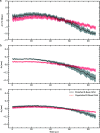Shot-to-shot two-dimensional photon intensity diagnostics within megahertz pulse-trains at the European XFEL
- PMID: 35787559
- PMCID: PMC9255581
- DOI: 10.1107/S1600577522005720
Shot-to-shot two-dimensional photon intensity diagnostics within megahertz pulse-trains at the European XFEL
Abstract
Characterizing the properties of X-ray free-electron laser (XFEL) sources is a critical step for optimization of performance and experiment planning. The recent availability of MHz XFELs has opened up a range of new opportunities for novel experiments but also highlighted the need for systematic measurements of the source properties. Here, MHz-enabled beam imaging diagnostics developed for the SPB/SFX instrument at the European XFEL are exploited to measure the shot-to-shot intensity statistics of X-ray pulses. The ability to record pulse-integrated two-dimensional transverse intensity measurements at multiple planes along an XFEL beamline at MHz rates yields an improved understanding of the shot-to-shot photon beam intensity variations. These variations can play a critical role, for example, in determining the outcome of single-particle imaging experiments and other experiments that are sensitive to the transverse profile of the incident beam. It is observed that shot-to-shot variations in the statistical properties of a recorded ensemble of radiant intensity distributions are sensitive to changes in electron beam current density. These changes typically occur during pulse-distribution to the instrument and are currently not accounted for by the existing suite of imaging diagnostics. Modulations of the electron beam orbit in the accelerator are observed to induce a time-dependence in the statistics of individual pulses - this is demonstrated by applying radio-frequency trajectory tilts to electron bunch-trains delivered to the instrument. We discuss how these modifications of the beam trajectory might be used to modify the statistical properties of the source and potential future applications.
Keywords: European XFEL; MHz XFEL; X-ray free-electron lasers; XFEL radiation; beam imaging; photon diagnostics; source characterization.
open access.
Figures







References
-
- Abbey, B., Dilanian, R. A., Darmanin, C., Ryan, R. A., Putkunz, C. T., Martin, A. V., Wood, D., Streltsov, V., Jones, M. W. M., Gaffney, N., Hofmann, F., Williams, G. J., Boutet, S., Messerschmidt, M., Seibert, M. M., Williams, S., Curwood, E., Balaur, E., Peele, A. G., Nugent, K. A. & Quiney, H. M. (2016). Sci. Adv. 2, e1601186. - PMC - PubMed
-
- Abeghyan, S., Bagha-Shanjani, M., Chen, G., Englisch, U., Karabekyan, S., Li, Y., Preisskorn, F., Wolff-Fabris, F., Wuenschel, M., Yakopov, M. & Pflueger, J. (2019). J. Synchrotron Rad. 26, 302–310. - PubMed
-
- Allahgholi, A., Becker, J., Delfs, A., Dinapoli, R., Goettlicher, P., Greiffenberg, D., Henrich, B., Hirsemann, H., Kuhn, M., Klanner, R., Klyuev, A., Krueger, H., Lange, S., Laurus, T., Marras, A., Mezza, D., Mozzanica, A., Niemann, M., Poehlsen, J., Schwandt, J., Sheviakov, I., Shi, X., Smoljanin, S., Steffen, L., Sztuk-Dambietz, J., Trunk, U., Xia, Q., Zeribi, M., Zhang, J., Zimmer, M., Schmitt, B. & Graafsma, H. (2019). J. Synchrotron Rad. 26, 74–82. - PMC - PubMed
-
- Altarelli, M., Brinkmann, R., Chergui, M., Decking, W., Dobson, B., Düsterer, S., Grübel, G., Graeff, W., Graafsma, H., Hajdu, J., Marangos, J., Pflüger, J., Redlin, H., Riley, D., Robinson, I., Rossbach, J., Schwarz, A., Tiedtke, K., Tschentscher, T., Vartaniants, I., Wabnitz, H., Weise, H., Wichmann, R., Witte, K., Wolf, A., Wulff, M. & Yurkov, M. (2006). XFEL Technical Design Report, DESY 2006-097. DESY, Hamburg, Germany.
-
- Ayyer, K., Xavier, P. L., Bielecki, J., Shen, Z., Daurer, B. J., Samanta, A. K., Awel, S., Bean, R., Barty, A., Bergemann, M., Ekeberg, T., Estillore, A. D., Fangohr, H., Giewekemeyer, K., Hunter, M. S., Karnevskiy, M., Kirian, R. A., Kirkwood, H., Kim, Y., Koliyadu, J., Lange, H., Letrun, R., Lübke, J., Michelat, T., Morgan, A. J., Roth, N., Sato, T., Sikorski, M., Schulz, F., Spence, J. C. H., Vagovic, P., Wollweber, T., Worbs, L., Yefanov, O., Zhuang, Y., Maia, F. R. N. C., Horke, D. A., Küpper, J., Loh, N. D., Mancuso, A. P. & Chapman, H. N. (2021). Optica, 8, 15–23.
LinkOut - more resources
Full Text Sources

